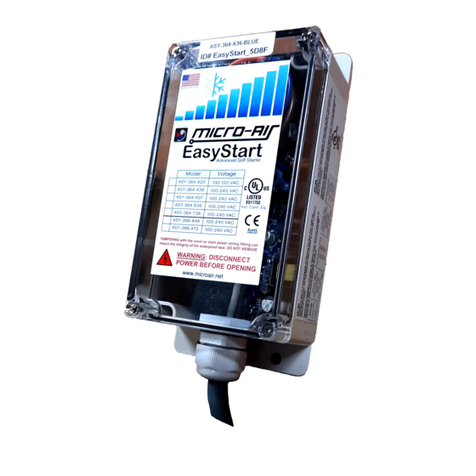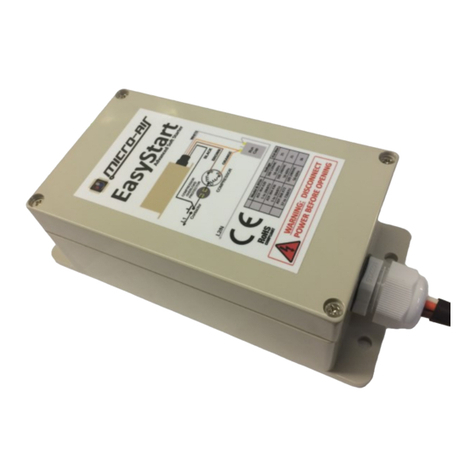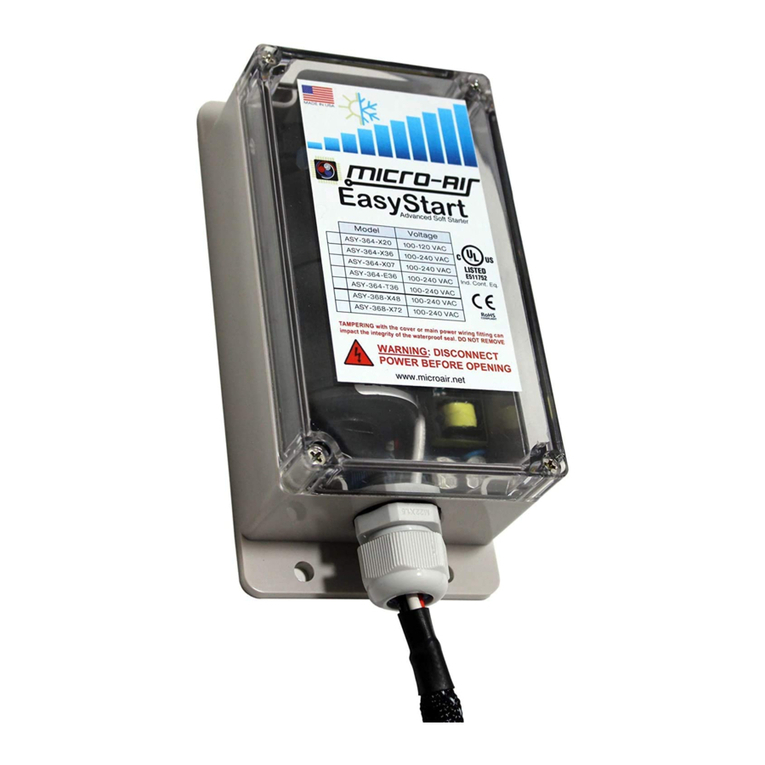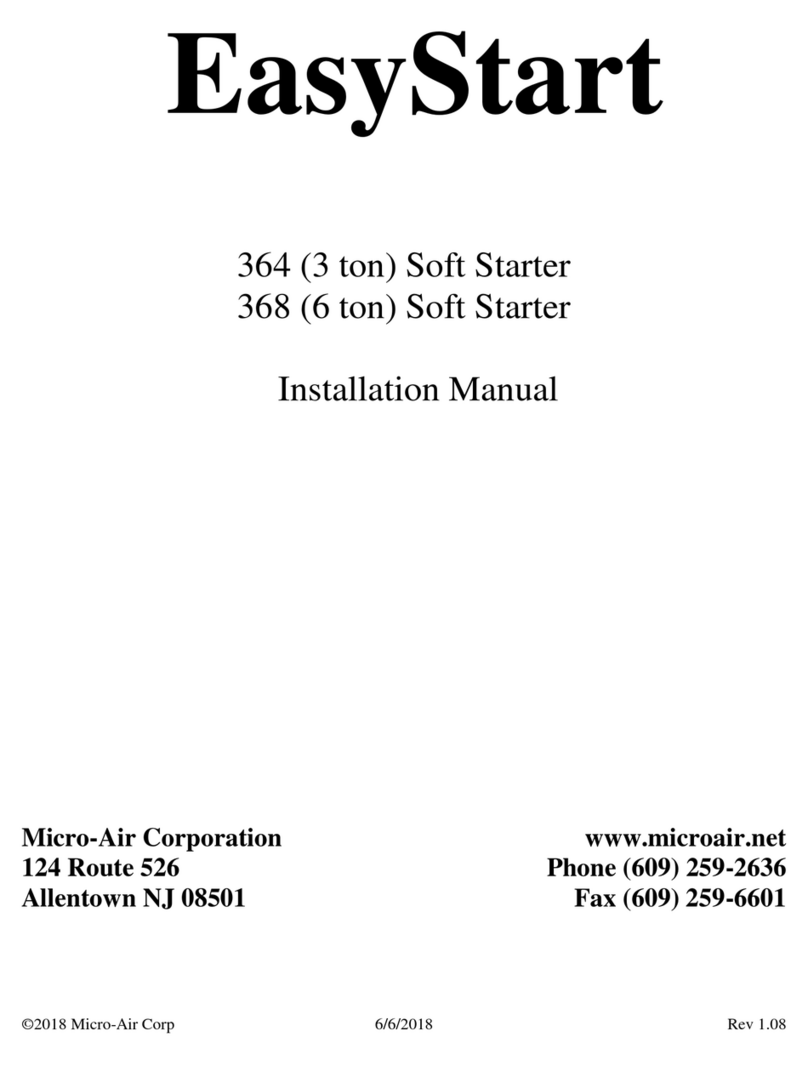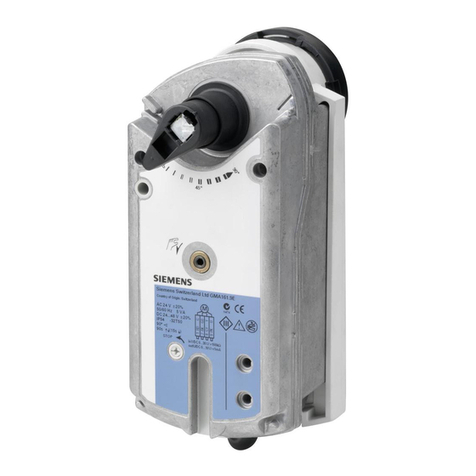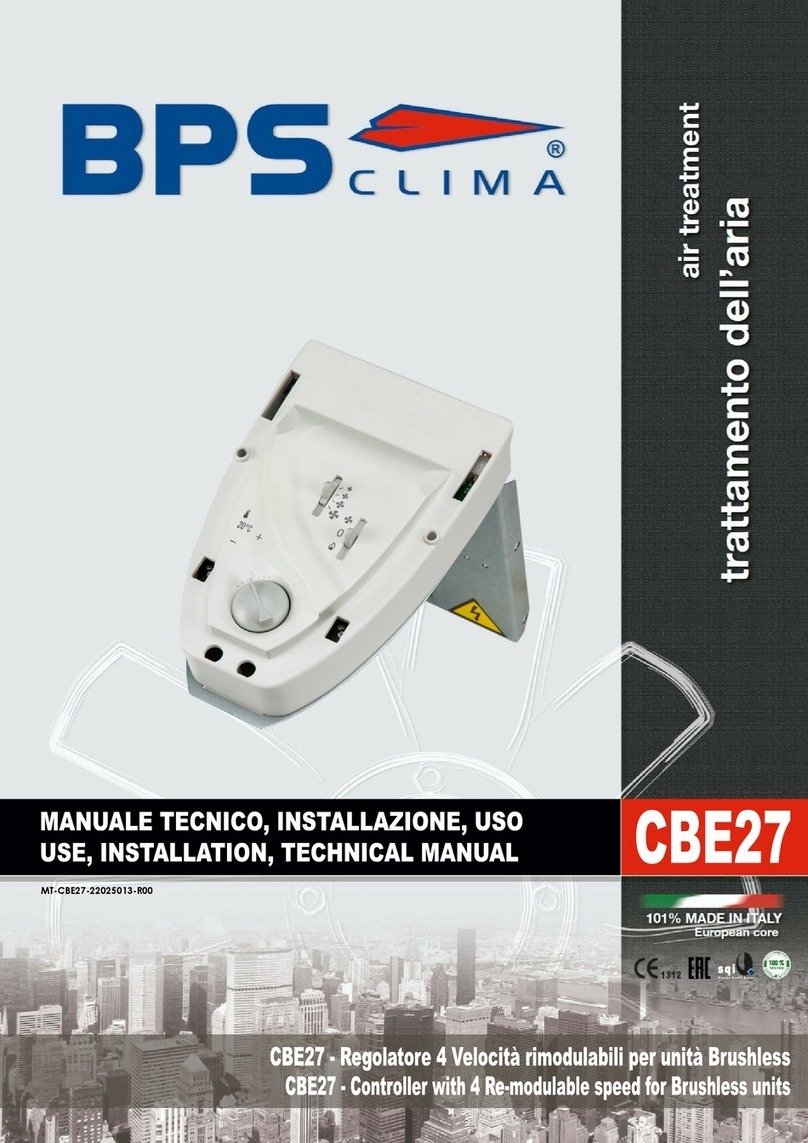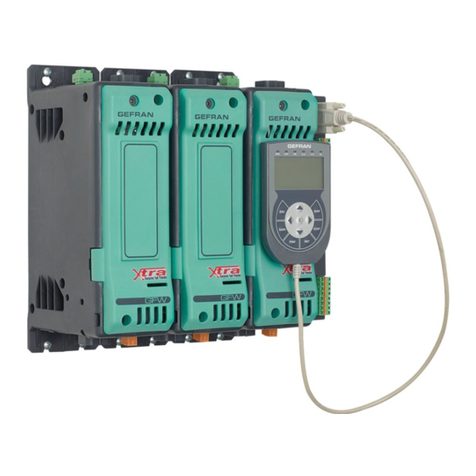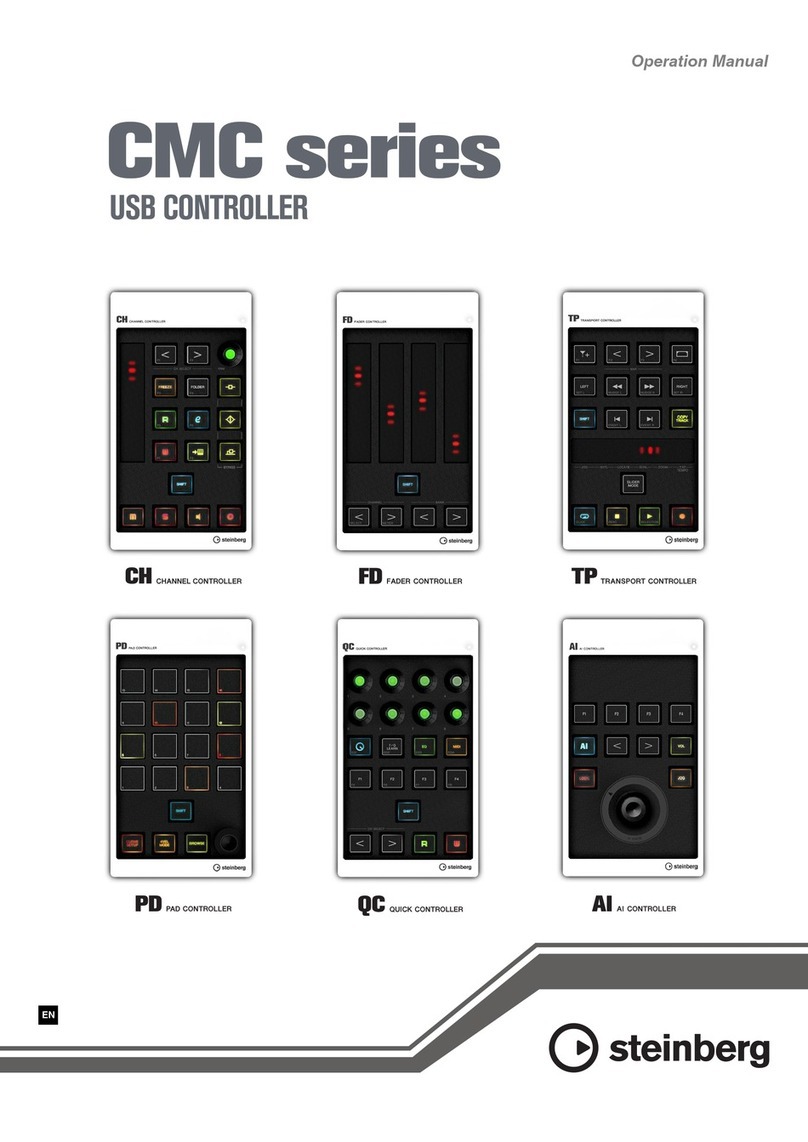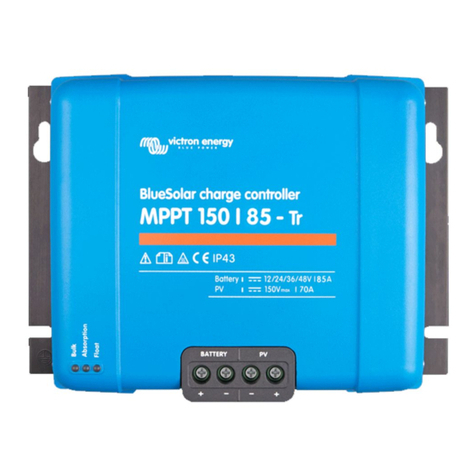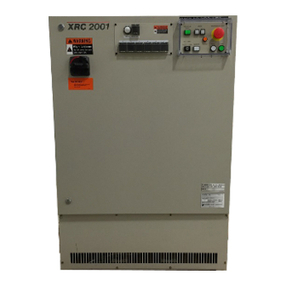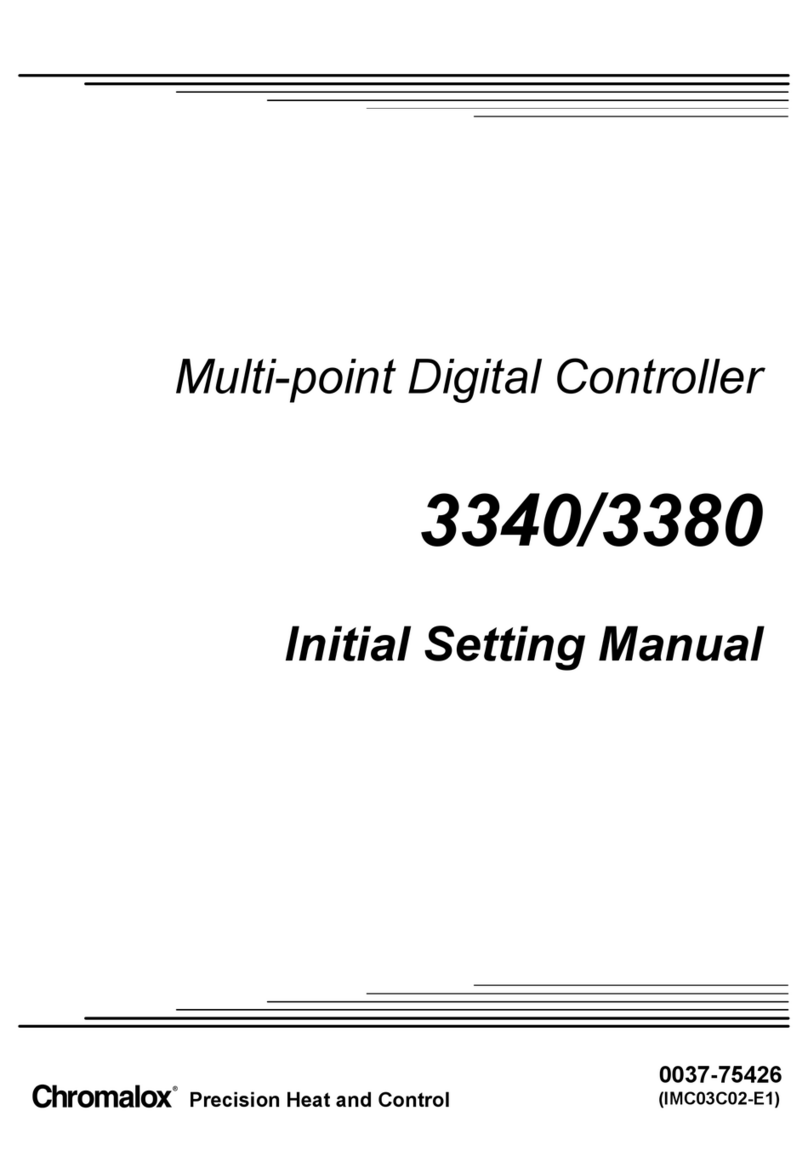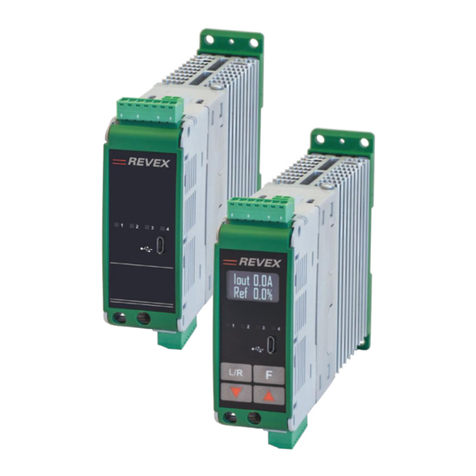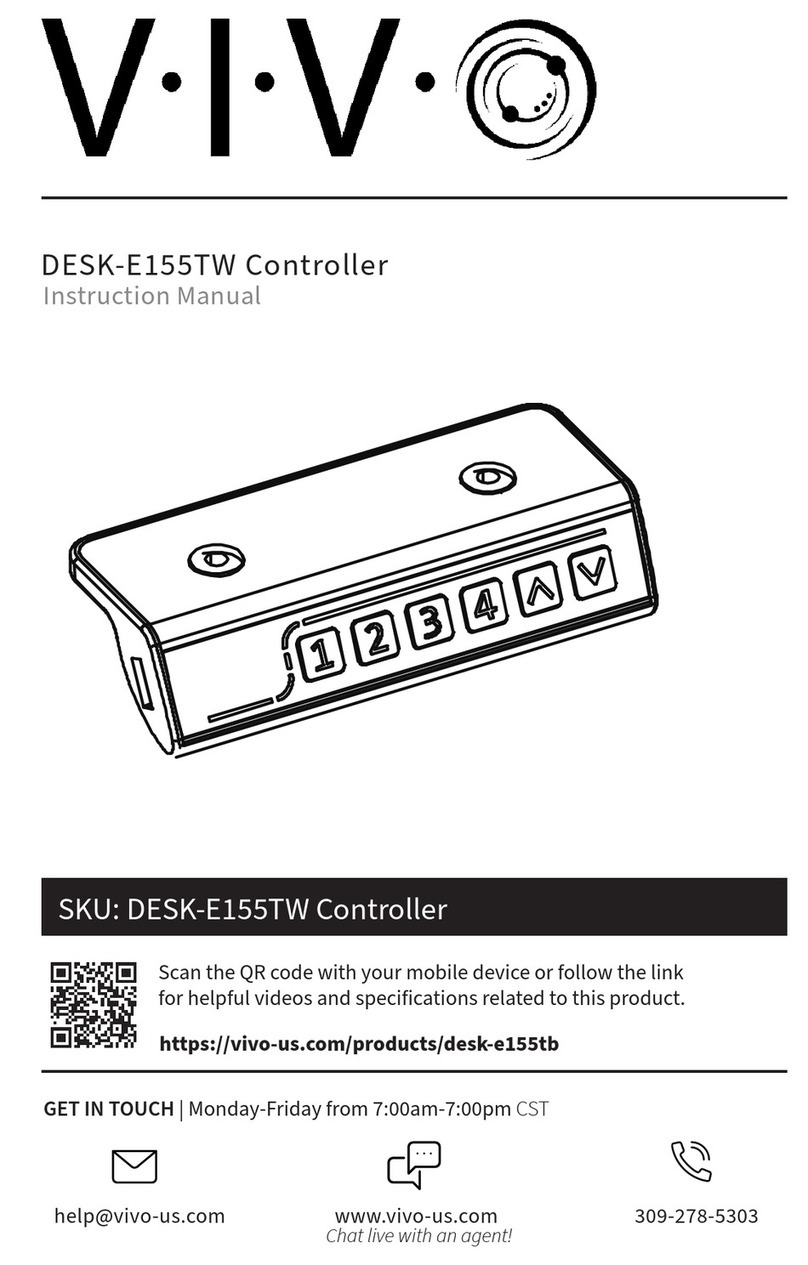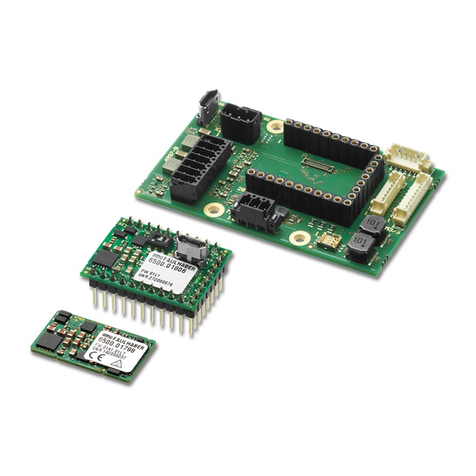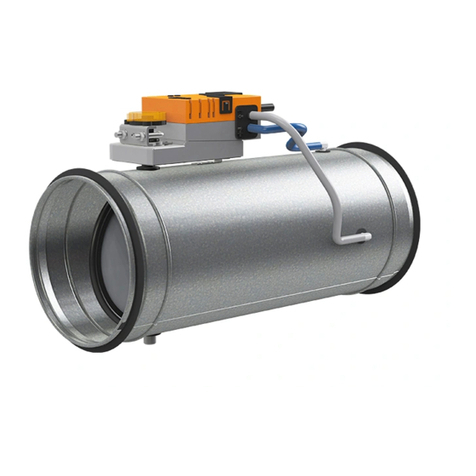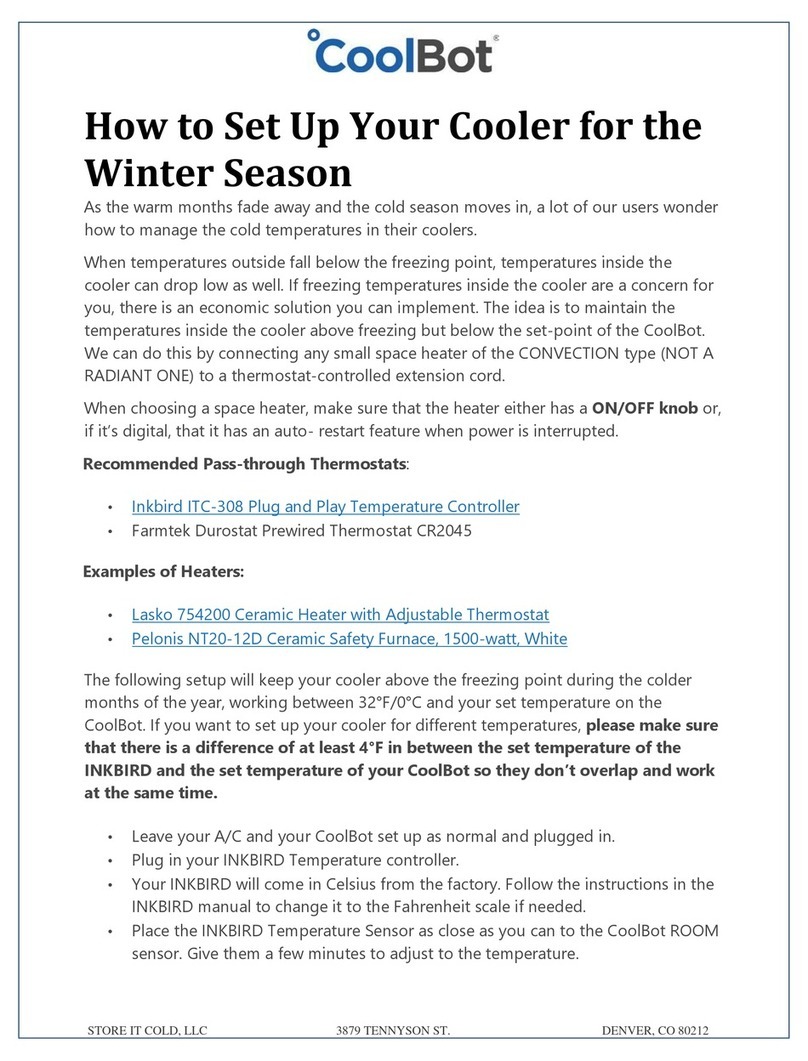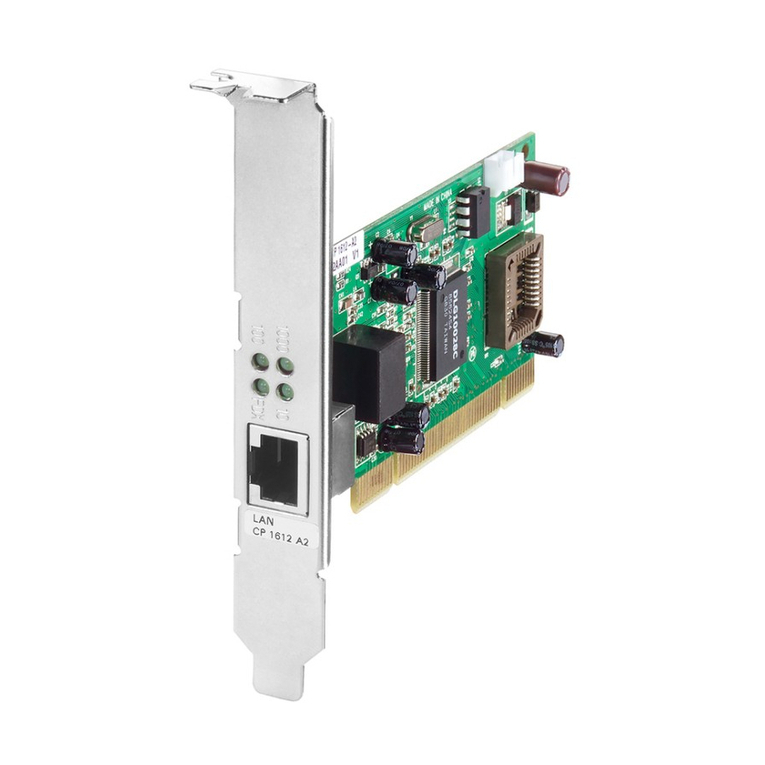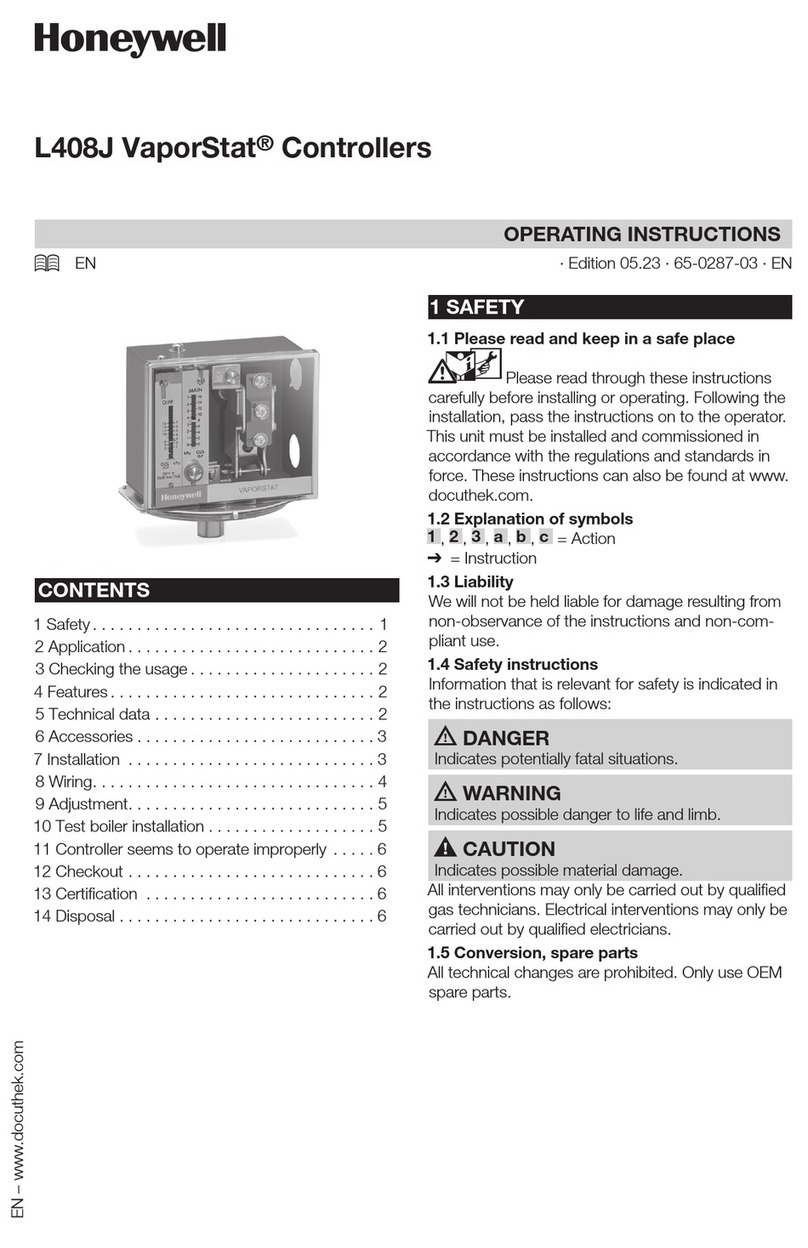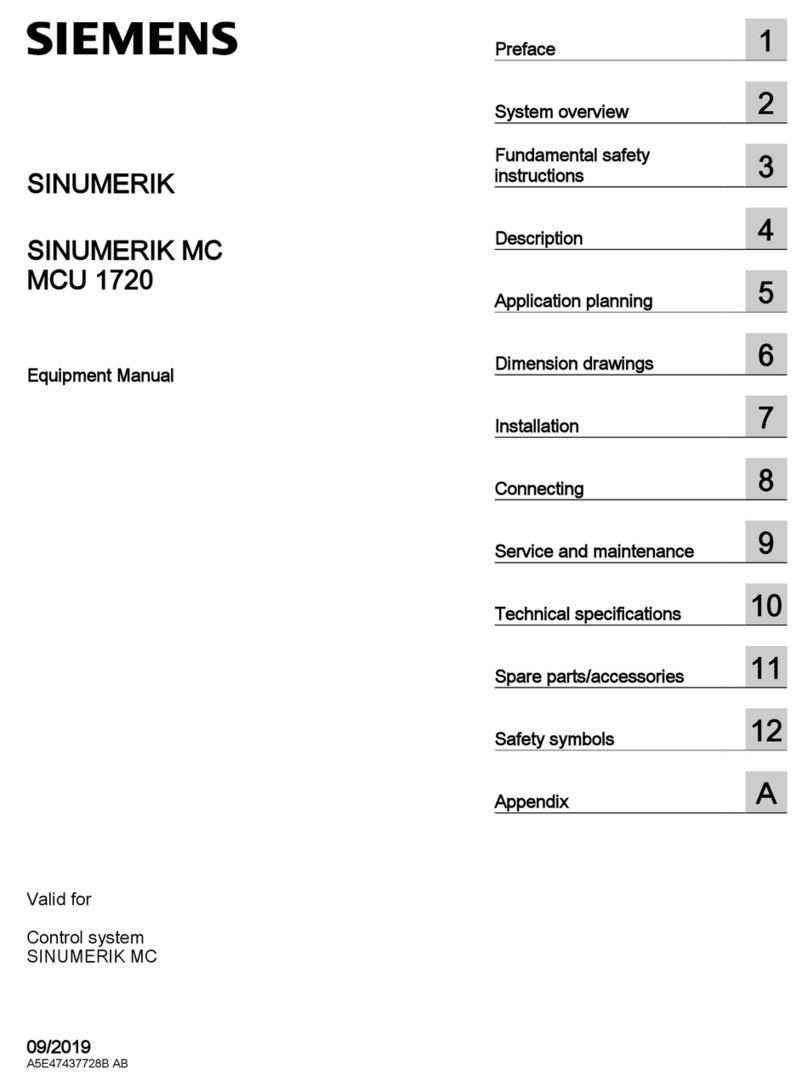MICRO-AIR EASYSTART Setup guide

Advanced EasyStart Troubleshooting
EasyStart is designed for excellent reliability and durability. Every EasyStart is tested on a
compressor before it leaves Micro-Air to ensure it will work when delivered. This document is provided
in the event there is a problem with installation or operation, to help determine if EasyStart is the cause
of the problem.
This document is separated into sections that guide troubleshooting from new installations to
existing systems. Understanding the short cycle timer is important to troubleshooting. Read that section
then jump to the section that applies to your situation.
**Note: Some testing in this document involves testing with live AC utility
power. This power can cause serious or fatal injury if mishandled. This testing
should be done only by qualified and trained service persons.

2
©2020 Micro-Air Corp. Rev 1.5
Table of Contents
The Short Cycle Timer...................................................................................................................................3
Troubleshooting New Installations...............................................................................................................3
Troubleshooting Generator Only Problems..................................................................................................6
Starting then shutting off..........................................................................................................................6
Testing your generator .............................................................................................................................7
Does not run at all on a generator............................................................................................................7
Troubleshooting Previously Working Systems..............................................................................................8
Checking Trouble Lights............................................................................................................................8
No trouble lights on ..............................................................................................................................8
Trouble lights are on.............................................................................................................................9
Trouble light definitions................................................................................................................................9
Unexpected current..................................................................................................................................9
Over current..............................................................................................................................................9
Power interruption / Short cycle timer.....................................................................................................9
Open compressor overload ......................................................................................................................9
Stall............................................................................................................................................................9
Wrong line voltage..................................................................................................................................10
No signal from start winding...................................................................................................................10
Testing for a no signal problem ..........................................................................................................10
Additional power interruption fault information .......................................................................................11
Common Causes..................................................................................................................................11

3
©2020 Micro-Air Corp. Rev 1.5
The Short Cycle Timer
EasyStart has a timer that prevents EasyStart from restarting the compressor for three or five
minutes from the time the compressor is stopped and includes failed start attempts. This helps prevent
damage to the compressor and start capacitor due to repetitive starting. This timer is also necessary to
ensure pressure equalization occurs before the next start. This timer remains active even after EasyStart
has lost power. EasyStart units with revision B21 and later have a three minute timer.
EasyStart will display a short cycle trouble light if power is applied before the timer has elapsed.
Since most thermostats will apply power earlier than the short cycle delay expiration, it is a common
occurrence to see these lights indicating a short cycle. Once the timer expires, the compressor will start
and operate normally and the fault lights will be cleared. This condition is not a problem but is normal
operation that does not require troubleshooting.
Certain marine and home systems may not require this timer so it can be disabled. See the
product operating manual for details on disabling the timer for these systems.
Troubleshooting New Installations
If your EasyStart is new and it has never run on shore or AC utility power and you can’t get it
running this section is the place to start. Most times installers have already checked the wiring several
times by the time they read this. This section is a comprehensive look at each connection and what to
look for to help find what may have been missed during installation. Please take the time to consider
this a fresh look at what you have already checked.
1. Are you powered by a power source that will normally start the compressor?
We recommend starting the compressor on adequate AC utility power but some
systems only have generator power available. If this is the case then you must use a higher-
wattage generator that can reliably start the compressor without EasyStart for the learning
starts.
In cases where you have no choice but to use a smaller generator, always make sure
that when conducting the 5-start learning process, any economy mode is turned OFF. After
the 5-start learning process is completed, economy mode can be turned back on.
2. Is the thermostat set for cooling with the set point below the ambient (room)
temperature?
Quite a few customers just turn on the breaker and expect the compressor to start
without checking the thermostat!
3. Is the compressor running?
Since the compressor starts very smoothly many people don’t realize the compressor is
running over the noise of the fan. Turn off the breaker and wait 5 minutes. Place your hand
on the side of the compressor and have an assistant turn on the power. The fan should start
and shortly thereafter the compressor should start. Note if the compressor attempts to start
and shuts off continue with steps 4 through 7.

4
©2020 Micro-Air Corp. Rev 1.5
4. Is the brown wire from EasyStart connected to the compressor R winding only? On the top
of the compressor there is a cover held by a single hex nut that looks similar to the one
pictured below:
Some caps have the windings marked on the top as shown while others have markings
inside the cap. Some compressors also stamp a letter on the compressor housing to indicate
the connections.
Use these markings to identify the color wire your compressor uses for the “R”
connection. This wire must connect to the brown wire from EasyStart and is usually white in
many installations. Follow the wire from the compressor to the electrical box and verify that
is connects to the brown wire from EasyStart in the electrical box.
The next step will require identification of the “S” wire. Note the color of the “S” wire
and follow it through the wiring harness to the run capacitor.

5
©2020 Micro-Air Corp. Rev 1.5
5. Are the original start devices removed?
The Easiest way to check for start devices is to look at the connections on the run
capacitor. There are two styles of run capacitor as shown below. The right capacitor has
markings for each terminal (F or FAN, H or HERM, and C) while the left will have no
markings:
Notice that on the capacitors there are previsions for multiple connections. These
connections are organized into groups of one to four connections. The “S” wire followed at
the end of the previous step should connect to the HERM terminal on the three-terminal
capacitor and one of the two terminals on the two-terminal capacitor. This terminal group
on two terminal capacitors can be considered the HERM terminal group. The Orange wire
from EasyStart must connect to HERM terminal group.
Remove any additional wires connected to the HERM terminal group. These wires
connect to start components that are no longer used and must be removed. Follow the
wires to their end connections. If the connection is a spade style connection to a run
capacitor or circuit board, simply remove the wire. If the wire goes to a PTC device then the
device will have two wires going into it. Follow the second wire and disconnect it from its
connector. You can remove the PTC completely if desired as it is no longer used.
6. Is the white wire from EasyStart connected to L2 on the correct terminal on the run
capacitor?
In most installations (see exceptions below) the white wire from EasyStart will be
installed on a terminal group on the run capacitor. For run capacitors with 3 terminals the
white wire should be connected to the “C” terminal. For run capacitors with two terminals
the white wire from EasyStart should be connected to the terminal group opposite the
HERM terminal group.
Exceptions: Compressors larger than 3 tons (36 KBTU) must connect the white wire directly
to line L2. Run capacitor terminals are not rated to carry currents found in these larger
systems.

6
©2020 Micro-Air Corp. Rev 1.5
7. Is the black wire from EasyStart connected to the compressor common winding?
Step 4 identified the compressor wiring cover and run winding wire. Identify the
compressor “C” winding wire color using the same steps in step 4. Follow the wire through
the wire harness to the connection at the contactor, relay or circuit board. Verify that the
Black wire from EasyStart is connected somewhere along that wire or on the contactor for
larger systems.
If steps 1 to 7 do not yield a solution, go to the Checking Trouble Lights section and check the
state of EasyStart.
Troubleshooting Generator Only Problems
If your system works as expected on utility power and does not start or starts and shuts off on
generator power, this section is the place to start.
Starting then shutting off
This could mean it runs for a few seconds or 10 minutes or more before it shuts off. Be sure
the thermostat did not turn off the compressor then read the following:
EasyStart takes itself out of the circuit after the start is complete. It does remain active
monitoring for faults that could indicate a generator overload. If it detects these faults,
EasyStart will shut down the compressor and wait 5 minutes before restarting. These faults are
caused by the power source and not by EasyStart. Some common causes of generator problems
are:
•Obstructed air or fuel filters, bad fuel, dirty fuel delivery systems.
•Excessive loading on generator: Small generators like 2000-watt units are often running
close to maximum capacity to run an Air Conditioner. Auxiliary loads like battery
chargers or converters, refrigerators, and water heaters can be enough to cause a
generator overload.
•Elevation: Motors in generators are calibrated to meet emissions standards at sea level.
As elevation rises the motors run richer and power output drops. Generators operated
above 5000 feet sometimes need to be recalibrated for proper operation.
•Temperature: High temperatures cause an increase in refrigerant pressure and higher
compressor current. Be sure Air conditioner vents and fins are clear of dirt and debris.
Verify using a clamp on current meter that the air conditioner is not drawing more than
the generators rated power output.

7
©2020 Micro-Air Corp. Rev 1.5
Testing your generator
A generator is a limited resource for power and an Air Conditioner draws most of the power a
small generator can produce. The following test will help verify your generator has not exceeded its
continuous duty ratings.
To measure current from your generator
you will need an Amp Clamp meter. Clamps similar
to the one pictured are available online and from
home centers nearly everywhere.
We constructed a simple test plug that we
could plug between our generator and the line
cord. A short length of #12 power cord is connected
to the plugs at both ends. The outer jacket is
removed from center of the cable to expose the
insulated wires inside. The clamp is connected
around the black wire only to read current.
You may have a different method or location to make this measurement. Just be sure the
measurements are made at a location that includes all loads on the generator.
Run the AC on a reliable source that will run the AC for long enough to get a steady reading.
That reading should be below the continuous duty rating of your generator.
Does not run at all on a generator
If it does not run at all on a generator but runs fine on shore power here are some possible
causes.
1. Wiring is not correct. Usually the original start components were left connected although
other wiring mistakes are also possible. Follow the steps in “Troubleshooting new
installations” before proceeding to #2.
2. The generator is not supplying the power needed to run the compressor. This is unusual if
you have taken the time to properly size your generator. In that case, you may have a
problem with fuel, air or spark delivery that is preventing the generator from delivering the
rated output.
3. Start capacitor in EasyStart is the wrong size. Call Micro-Air for other systems after making
the above checks. Please have your compressor voltage, model, BTU rating and original start
capacitor size available when you call. If this is a 120 volt RV rooftop air conditioning
system this is not a possibility with the standard 364 115 V only RV AC (-X20-IP).

8
©2020 Micro-Air Corp. Rev 1.5
Troubleshooting Previously Working Systems
If your EasyStart was working as expected on generator, inverter, and utility power then this is the
section to start. Do all testing on AC mains or shore power.
1. Are all the connections still good? Check all four connections to EasyStart. Pull on crimp
joints and check spade connection tension to verify they are all good connections.
2. If your compressor is running for a short time on generator then shutting off, follow the
instructions in section: Testing your generator. Be sure the running current does not exceed
the maximum current the generator can deliver.
3. Go to the “Trouble Lights” section and check the state of EasyStart.
Checking Trouble Lights
EasyStart models vary in style as the product has developed. Very early models had black boxes
and no indicator lights. The models were changed to a beige colored box with a solid lid. A short time
later the lids were changed to clear to permit viewing the trouble lights without removing the cover.
Bluetooth models do not have trouble lights and can be tested using an app on a smart device. If your
model has trouble lights, please proceed with this section.
Two styles of indication are available on trouble light models. Early styles have three lights
labeled D12, D22 and D23. Later models have flashing lights. These lights will flash from one to seven
times with a pause in between.
Remove power for five minutes to check the trouble lights. This allows the timer in EasyStart to
expire so the next start will occur right away. Next have a helper apply power while you are touching the
compressor. Be sure the thermostat is set to turn in the compressor. The fan should start and the
compressor should operate a few seconds after the fan. If the compressor fails to start then look at the
trouble lights.
No trouble lights on
If no lights are on or you are getting a stalled compressor indication, power to EasyStart should
be verified. This is done by connecting an AC voltmeter to the black and white leads connected to
EasyStart. The connection will vary by installation but most times, the L2 connection can be made at the
run capacitor “C” or common terminal. The other connection to the black wire should be made at a
convenient spot such as the contactor, relay, or junction where it intersects the compressor “C” winding
terminal.
Turn off auto ranging on your digital meter and set it to read ac line voltage. Turn off power to
the compressor for 5 minutes then connect your meter. Have an assistant apply power and set the
thermostat to start the compressor. When the thermostat turns on the compressor you should see full
line voltage at the measurement points. A few seconds later the compressor should attempt to start.
Note the lowest voltage seen on the meter when the compressor is starting.
If no voltage or low voltage is measured then the thermostat is not turning on the compressor.
Check your supply, breakers and thermostat for problems. Low voltage is anything less than full line
voltage. There is no problem with EasyStart.
If the voltage is line voltage then drops more than 10% during the start such as a 120-volt line
dropping below 108 volts, then there is a problem with the supply. This can be a problem at the source

9
©2020 Micro-Air Corp. Rev 1.5
such as the generator or AC mains plug, a problem with the distribution panel, problem at the outlet or
plug, or a problem with the wiring. There is no problem with EasyStart.
If there is power and after 10 seconds there is no lights inside EasyStart, EasyStart must be
returned for service. Follow the instructions at https://www.microair.net/pages/service to return
EasyStart. Be sure to include a description of the problem.
Trouble lights are on
If lights are lit than check the result on the following chart then see the trouble light definitions
for more information.
D21
D22
D23
Flashes
Unexpected current
NA
NA
NA
1
Over Current
ON
2
Power interruption / Short cycle timer
ON
ON
3
Open compressor overload
ON
4
Stall
ON
ON
5
Wrong line voltage (pertains to –X20-IP 120V model only)
ON
ON
6
No signal from start winding
ON
ON
ON
7
Trouble light definitions
Unexpected current
This fault can indicate a problem during the learning process or a problem with EasyStart. If re-
learning does not fix the problem, contact Micro-Air for possible servicing of EasyStart.
Over current
Compressor run current has exceeded the maximum value allowed by the device or the
maximum value calculated during the learning process. In many cases re-learning EasyStart can clear this
problem. This can also be caused by a failing compressor, poor condenser flow, or bad run capacitor.
Power interruption / Short cycle timer
In addition to the short cycle delay this indication provides, it also provides indication of a short
duration power interruption. Compressors will stall after only a few lost cycles of AC energy creating a
huge load when power is restored. EasyStart has built in fault detection for this condition so breakers
and generators do not overload and trip. EasyStart will shut down the compressor when detected for a
short cycle delay (three or five minutes), then automatically restart the compressor following this delay.
Open compressor overload
The compressor overload in the common winding connection is open. This indicates poor
air/water flow (i.e. overheated condenser) or a problem with the compressor.
Stall
EasyStart has detected that the compressor cannot start or has reduced its speed and will stall.
This fault can be caused by an improperly sized or bad start capacitor in some systems. Note: RV systems
are universal and do not have problems related to the start capacitor sizing. Stalling is usually a wiring
related issue in these systems. This is also a problem that can be caused by the output voltage collapse

10
©2020 Micro-Air Corp. Rev 1.5
on generator power due to high altitude or engine performance problems. Follow the steps in the
“Verifying power to EasyStart” section.
Wrong line voltage
The 120V-only RV EasyStart (-X20-IP) cannot be used in 220V applications.
No signal from start winding
The most common causes of this problem is:
•The orange wire is not connected to the start winding.
•The Compressor Start winding is open.
•Line L2 is connected directly to the compressor start winding.
Testing for a no signal problem:
Turn all power off. Verify there is continuity from the black wire to the orange wire at the wire
connection points. This connection will give only the very low resistance of the common to start winding
connection when it is properly connected. The flow of this path is down the orange EasyStart wire to the
run capacitor. Through the capacitor terminal to the start winding. Through the start winding wire to the
start winding. Out the compressor common terminal and through the overload. Out the overload and
through the compressor common wire. The compressor common wire should be joined with the
EasyStart black wire which completes the path. Any break in this path indicates a problem and will cause
a fault. Correct the open in this path to fix this fault.

11
©2020 Micro-Air Corp. Rev 1.5
Additional power interruption fault information
Common Causes
The most common reason for this to occur while on AC mains power is AC power inverters in RV
systems. These devices automatically switch on AC power from the batteries through an inverter when
the RV is unplugged. If you can unplug your RV and still have AC power then you have one of these
inverters. The load that appears when the compressor starts is often enough to trigger the switch over
to the inverter. The solution is to reduce the switchover voltage point on the inverter by changing its
setting. We have seen switchover points set typically to 115 VAC and should be reduced as low as
possible.
Faulty surge protectors can also cause power interruption. Try removing or disabling your surge
protector to see if that fixes the problem.
Power source overloading is also a cause for power interruption. Inverter generators will
commonly reduce the output if the generators motor cannot keep up. This keeps the motor from
stalling but also slows the air conditioner which will trip the breaker or overload when the generator
resumes supplying power. Be sure all the loads are off in the RV when operating your air conditioner on
a limited power source. Additional help for generator related issues can be found in our manual
accompanying our generator test kit available at www.microair.net .
Input drop on battery to AC line inverters is also a common cause. High internal resistance on
the cells, using improperly gauged wire, and poor quality inverters can contribute to these problems.
Finally, faulty breakers, undersized extension cords, bad plugs or outlets, and poor wiring can
also cause interruptions in power. Checking all of these is beyond the scope of this guide. We have
heard comments from customers like “if I put it back to factory it will work”many times. Please know
that if EasyStart is reporting there is a problem with interrupted power, there is a problem that needs to
be addressed.
Other manuals for EASYSTART
2
Table of contents
Other MICRO-AIR Controllers manuals
